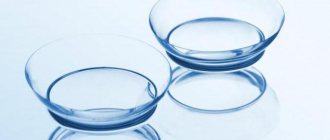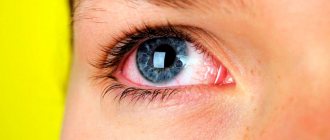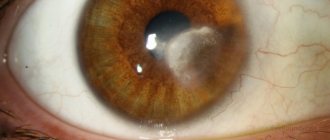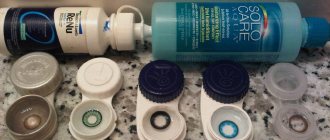Contact lenses are a convenient universal device for correcting visual acuity.
Since its inception, this type of optics has been surrounded by many rumors, most of which have not found practical confirmation. One of the main dilemmas faced by the buyer is related to the safety of using contact optics. Is it harmful to wear lenses, do they worsen vision, how can you tell if the product is selected or used incorrectly? Everything you wanted to know about contact lenses can be found in this article.
Are the concerns justified?
The first contact lenses (CL), which began to be produced en masse in the 50-60s of the twentieth century, were made exclusively from organic glass. Wearing them caused discomfort, created a feeling of a foreign body in the eye and created an obstacle to oxygen access. Constantly wearing such lenses was uncomfortable and dangerous for the cornea, which was deprived of proper breathing.
Modern CLs are made from biocompatible water-gradient materials, such as silicone hydrogel. It does not cause irritation to the tissues of the ocular apparatus, supports the natural environment of the organ of vision and does not impede metabolic processes.
If all medical requirements are met (they will be discussed below), wearing CL will not only be safe, but even useful.
In addition, there is a misconception that contact lenses should not be worn by people over 40 years of age - contact optics can be safe at any age .
Can vision deteriorate?
Proponents of the arguments against wearing lenses argue that any optics significantly impairs visual acuity. They attribute this to the fact that the eyes in the CL stop “working”, since all visual functions are taken over by the optics. Only the illusion of good vision is created, but in reality it is rapidly deteriorating.
A counterargument can be put forward to this statement: vision can deteriorate on its own, regardless of whether the patient wears a CL or not . The sensation of decreased acuity is based on contrast. The picture created by the lens is very natural, bright and clear. When the patient removes the optics, the image immediately loses contrast and saturation. Therefore, a false impression is created that vision has deteriorated, and the reason for this was contact lenses.
It is also erroneous to say that CLs lead to the development of myopia in childhood. Studies have shown that there is no decrease in visual acuity in children who were prescribed lenses . On the contrary, any optics can have a therapeutic effect specifically for young patients, helping to get rid of farsightedness or myopia.
Classification of eye lenses
It will become easier to understand what will happen if you wear expired lenses and what the optimal period is when you understand the classification of these devices. They are distinguished by the characteristics of the material, wearing mode, replacement period, and purpose. So, they sell hard and soft lenses. The former are divided into gas-permeable and gas-tight. The latter are classified into hydrogel and silicone hydrogel. Different materials give you the opportunity to choose - high permeability or eye protection from ambient air, excellent elasticity or shape retention.
According to wearing mode:
- daytime - removed at night;
- flexible – allowed to sleep 1-2 nights;
- prolonged – up to 6 days in a row;
- continuous – up to a month (30 days).
For how long you can wear lenses of a particular brand and model, check in the instructions or with your doctor. Here lies the main reason why people “go into overdue.” They get used to one type and when changing options they get confused with the timing. This becomes noticeable if a person is used to “breaking a little” even when wearing the same model.
Lenses are classified according to their purpose:
- optical – correct visual impairment;
- spherical – correct myopia (nearsightedness) or hypermetropia (farsightedness);
- toric – compensate for astigmatism;
- multifocal – compensates for defects from presbyopia.
They also produce untinted, tinted and painted optical lenses. They completely or partially change the color of the eyes, creating the desired decorative effect. They also sell lenses that highlight the natural shade. It turns out that such optics are used not only for correctional, but also for cosmetic purposes.
Are lenses without diopters harmful to vision?
Colored lenses without diopters can be used if your vision is good, but you want to slightly change your image. They are made from the same material as regular CLs, only with the addition of pigment. The dye allows you to radically change the color of your eyes or highlight the beauty of your own iris shade.
The pupil area in colored lenses remains uncolored, the pigment does not come into contact with the membranes, and therefore does not in any way affect the quality of vision and the health of the eye as a whole. If all the conditions for using color contact lenses are met, devices without diopters will be absolutely safe.
ARTICLES ON THE TOPIC:
- Tips on which contact lenses are best to choose for vision correction, among...
- How to choose the right colored contact lenses and not be disappointed by the change...
- Important question! Are colored contact lenses harmful to the eyes, including for children...
But you must take into account an important nuance - contraindications. There are a number of pathological conditions of the organ of vision in which wearing contact lenses is prohibited.
Terms of wearing lenses
Contact lenses are designed for daily wear. Depending on the type of device, it is possible to extend the use of the product:
| Type of lenses | Time of continuous eye contact |
| Daytime view | 12-14 hours |
| Night wear | 8-10 hours |
| Flexible wearing period | Up to 12 hours + 2 or 3 nights in a row |
| Extended wear | 7 days and 6 nights |
| Continuous use | 30 days |
| Quarterly type | 3 months |
Colored lenses differ significantly in the material used to make them from vision correction devices. They are less breathable, which reduces their wearing time. Overuse of such products threatens to impair the functionality of the cornea. The device can be worn for no more than 4 or 5 hours a day. If there is eye discomfort, the product should be removed.
We recommend reading: What lenses can you sleep in?
The period of wearing the product depends on the material of manufacture and its ability to accumulate natural material from the mucous membrane of the eyes. The thinner and softer the substance used to develop the product, the more active the cumulation reaction occurs. Therefore, daily lenses are the most comfortable to wear, but within a day they are no longer suitable for further use.
When wearing a vision correction device throughout the day, the period of planned replacement is reduced by half.
For whom are they contraindicated?
Even the highest quality contact lens is considered a foreign body for the eye, since it is in direct contact with the mucous membrane, in contact with the eyelids and tear secretion. For this reason, ophthalmologists prohibit wearing contact lenses in case of inflammatory diseases of the tissues and membranes of the eyeball, such as:
conjunctivitis;
- keratitis;
- blepharitis;
- uveitis;
- scleritis;
- iridocyclitis;
- dacryocystitis;
- inflammation associated with allergic reactions.
A CL, which is placed on the inflamed membrane, will cause additional irritation and will delay the healing process for a long time.
There are other contraindications:
- subluxation of the lens;
- strabismus with an angle of 15 degrees or higher;
- drooping eyelid (ptosis);
- glaucoma;
- excessive or insufficient secretion of tears;
- xerophthalmia associated with increased dryness of the conjunctiva and cornea;
- obstruction of the lacrimal ducts.
Additional temporary contraindications include infectious and colds: sinusitis, rhinitis, influenza, ARVI, bronchitis, tuberculosis. With any infection, pathogenic bacteria end up on your hands and face. Therefore, when putting on lenses, you can introduce a virus or microbe to the mucous membrane of the eye. This can lead to the development of an infectious process in the structures of the eyeball, which becomes extremely dangerous for vision.
REFERENCE: With the advent of one-day silicone hydrogel lenses, diabetes mellitus was excluded from the list of prohibitions on wearing contact lenses.
How to make wearing SCL comfortable?
Many patients who use contact lenses are recommended to take Delfanto® capsules as a preventive measure for dry eye syndrome. This is an innovative drug based on the patented MaquiBright® extract. It contains a record amount of antioxidants – 35%.
Delfanto® capsules restore cells of the lacrimal glands, stimulate the production of natural tears and improve its quality. Within a month they eliminate the manifestations of dry eye syndrome by 45%.
The drug has a convenient release form - capsules of 30 and 60 mg. It can be used in conjunction with tear drops to improve the comfort of wearing contact lenses. 2-3 weeks after starting the Delfanto® course, you will be able to completely abandon ophthalmic solutions, while the comfort of wearing SCLs will remain until the end of their service life.
How do you know if lenses are not right for you?
CL is a special medical product that meets the most stringent standards. They are made from high-quality hypoallergenic materials and are therefore considered safe. Allergy to optics is practically excluded, so reactions intolerance to CL are very rare .
You can tell that contact optics are not suitable for a patient by the following symptoms:
photophobia;
- painful sensations in the eyes;
- swelling and tearing;
- redness of the eyes;
- burning sensation and dry eye.
Similar symptoms are usually accompanied by acute conjunctivitis, but lens intolerance can manifest itself in the same way. This phenomenon can be considered as a physiological reaction to a foreign body, which is CL. Signs of such pseudo-allergy are not uncommon among beginners who are just adapting to CL. Within a week, when the eye gets used to the optics, redness, burning and lacrimation should go away on their own.
ADVICE: Doctors prohibit beginners from wearing lenses without removing them. To quickly get used to contact lenses, you should wear them correctly for short periods of time and use moisturizing eye drops.
Contact vision correction and dry eye syndrome
If you wear lenses for longer than expected, xerophthalmia or dry eye syndrome may develop. When wearing SCLs, oxygen is supplied to the cornea due to the moisture present in their composition. The lens material itself does not have sufficient oxygen permeability. There are no blood vessels in the cornea, so it receives the necessary nutrients from its own tear fluid.
As the moisture evaporates, you may experience a feeling of dryness, foreign matter, or sand. Sometimes rapid visual fatigue and blurred vision are observed. If SCLs not intended for continuous wear are used for more than 10-12 hours in a row, corneal hypoxia may develop. This threatens a decrease in visual acuity and corneal edema.
What to do if you have symptoms of an allergy or intolerance?
If, 7 days after starting to use the lenses, signs of an allergic reaction are observed, it is necessary to find out the cause of the symptoms.
Allergic reactions to a specialized solution for CL. Often intolerance is caused by preservatives, which are necessarily included in the composition of the liquid. Sometimes allergies occur when changing the type or manufacturer of the solution. Solution : by trial and error, select the appropriate composition or switch to daily lenses that do not require the use of a solution.
Changing lens type. Incorrectly selected lenses, features of products of a certain brand can cause intolerance and discomfort. Solution : together with an ophthalmologist, select the “right” contact lenses.
Failure to comply with hygiene rules. Untimely change of solution, neglect of the timing of replacement of optics, insufficient cleaning can lead to the penetration of microbes into the mucous membranes of the eye and cause inflammation. The situation is also aggravated by protein deposits that accumulate on the surface of the lens and serve as a breeding ground for the proliferation of pathogenic microorganisms. Solution : strictly follow the rules of hygiene and the timing of wearing contact lenses.
General allergic reactions. Allergies to dust, plant pollen, and animal hair can aggravate CL intolerance. The contact of tiny particles of allergens with the lens can cause severe allergic reactions. Solution : visit an allergist to identify the type of irritant and draw up a treatment plan.
Only a doctor can accurately determine the cause of lens intolerance. Therefore, if severe allergy symptoms occur, you should seek medical help. The ophthalmologist will make an accurate diagnosis,, if necessary, refer for additional examinations and consultations, and then prescribe treatment.
IMPORTANT ! Discomfort in the eyes can be caused by an incipient corneal ulcer or infection, so consultation with a doctor is required.
Can the service life of SCLs be reduced?
Not in all cases, regular and colored lenses last as long as stated by the manufacturer. There are factors that can significantly accelerate the aging of the material and bring the planned replacement of SCL closer. Among them:
- hairsprays;
- cigarette smoke;
- evaporation of nail polishes;
- reuse of solution;
- insufficient removal of deposits.
Any infection makes the lenses unsuitable for further use. Their pathogens quickly settle and multiply on the surface. Even high-quality disinfection with a solution is not capable of destroying pathogenic microflora, so such SCLs can only be thrown away.
Are there any benefits from lenses?
Correctly selected lenses can have a positive effect on visual function and eye condition:
relieve the load on the muscular system of the eyeball;
- eliminate eye fatigue;
- serve as a therapeutic agent for children suffering from myopia and farsightedness;
- protect the eyeball from ultraviolet radiation (optics with a light filter);
- create the correct picture, do not distort the shape, size, distance to objects;
- help to build a correct image in patients with varying degrees of visual impairment in the right and left eyes;
- hide visible defects of the eyeball.
CLs are good because they allow you not to limit yourself in physical activity and sports . They do not fog up when the temperature changes and do not create inferiority complexes in children and adolescents.
How to wear CL correctly
The key rule for selecting lenses is consultation with an ophthalmologist. The specialist has the necessary diagnostic tools to examine vision, detect abnormalities and contraindications. The doctor will select the “correct” diopters and make recommendations for wearing optics.
What else needs to be observed:
- CL wearing mode – most often it is recommended to remove the optics at night and not use them for longer than the time specified in the instructions;
- expiration date - expired products must not be worn;
- hygiene rules - wash your hands thoroughly before putting on and taking off, use lint-free towels;
- moisturizing mode - special drops, similar in composition to tear fluid, will help eliminate discomfort.
Only daily lenses do not require special care. All other types of contact lenses must be properly stored, worn, and cleaned every day. For this purpose, special devices and entire sets have been invented, which include storage containers, tweezers and solutions. The optics should be treated after each removal and before putting them on. Between wearing periods, the products are placed in a special container with a solution that will disinfect the contact lenses and maintain the necessary moisture content of the material.
Compromise
Of course, ideally such problems should be eliminated by giving up bad habits, which will have a positive effect on vision and overall health. But if you can't quit smoking, try to minimize the risk. Follow all care rules:
- remove/put on lenses only with clean hands;
- do not overbear them;
- Monitor the expiration date of the multi-purpose solution.
We store and wear lenses correctly
Moisturizing the eyes is also very important for smokers. Experts advise them to wear only daily lenses made of breathable material (for example, BiotrueONEday, made of hypergel, due to which the eyes are 100% saturated with oxygen). All this provides increased comfort even for those who are constantly in contact with cigarette smoke. It is also important to choose the right multi-purpose solution. Modern products contain components that moisturize the surface of the lenses.
As a result, we note that most people who turn to optometrists are by no means ideal patients. And often the reason lies in bad habits, because smoking with contact lenses, as we have already found out, is prohibited. Moreover, even passive smoking can have a negative effect on contact lenses. Therefore, take care of your eyes!










